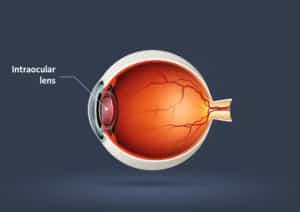Proudly Serving the Wilmington, NC & Cape Fear Areas

Technology has really changed the landscape of options patients have for replacing their cataract-clouded natural lens with an artificial intraocular lens. At Cape Fear Cataract & Cornea, we’re excited to offer the most recent addition, toric multifocal IOLs to correct astigmatisms and enhance the vision of patients with cataracts.
See What Our Patients Have To Say!
- Angie R.
To read more patient reviews, click here.
How Have Intraocular Lenses Changed?
When a cataract-clouded lens is removed, it needs to be replaced by an artificial lens. These are called intraocular lenses (IOLs). Prior to 2005, patients had to choose a single distance where these artificial lenses would focus, either distance vision or up-close vision. The patient would then wear glasses to correct the vision distance not addressed by the monofocal lenses, usually for up-close vision.
In 2005, the first multifocal IOLs came to market. This type of IOL provides correction for both near and distance vision, much like your eyes normally would. Both near and far objects can be in focus at the same time, so there is an adjustment period, but your brain learns to select the visual information it needs to form an image of either near or distant objects. Multifocal lenses also now correct for presbyopia, the condition that hits most people after age 40, where their near and intermediate vision usually needs correction with reading glasses.
What is Astigmatism?
But astigmatism was still a problem. Astigmatism is where the cornea is shaped more like a football than being round. This creates focusing problems at certain distances. In the past, IOLs could not correct astigmatism in cataract surgeries. Some astigmatism could be corrected during the actual surgery by making incisions in the cornea, known as limbal relaxing incisions. But these incisions could only address limited amounts of astigmatism, and the outcomes of this procedure could be variable.
What Are Toric IOLs?
In 2006, “toric” lenses were introduced. Toric IOLs have different powers in different meridians of the lens to correct the asymmetric power of the eye, the tenets of astigmatism. As with toric soft contact lenses for astigmatism, where each lens has a mark that shows where the orientation of the lens needs to be placed onto the eyeball, toric IOLs have special markers on the peripheral parts of the lens that show

Are There Any Downsides with Toric IOLs?
Candidates interested in Toric IOLS should be aware of a few risks that can come with this treatment. These include:
- Blurry vision
- Inconsistent vision
- Misaligned lenses
- No guarantee of 20/20 vision
Despite these downsides, Toric IOLs can help improve the symptoms candidates experience from astigmatism. This will help improve your vision, and it may eliminate your need for daily contact lenses or glasses.
What Are the Benefits of Toric IOLs?
At Cape Fear Cataract & Cornea, we primarily recommend the TECNIS Symfony and AcrySof IQ toric lenses. Both offer excellent multifocal lens vision, enabling patients to see clearly at all distances. These lenses both correct for astigmatism, and they can now correct for presbyopia. Presbyopia is the condition that afflicts virtually every human being after they turn 40. Presbyopia is when the lens in each of our eyes loses elasticity. This precludes the lens from being able to focus on up-close items. That’s why as we get older most of us have multiple pairs of reading glasses strategically placed throughout our homes.
So, what’s it worth to ditch the need for any eyeglasses? That’s the benefit of these new toric IOLs. Many patients have had to wear glasses to correct for near- or farsightedness their entire life. Even if you didn’t need glasses for refraction correction, just about every one of us still has presbyopia and rely on the ever-present “readers.”
Now you can go without it. How cool would that be? Freedom is what these new toric IOLs offer you. You’ll be able to see clearly at a distance, midrange, and up close. You could need reading glasses for the very fine print on a label or something like that, but you can be glasses-free in the vast majority of situations.
Who is a Good Candidate for Toric IOLs?
If you have astigmatism and prefer not to have to wear glasses for close up work such as reading or working on the computer, toric multifocal IOLs could be a great option for your cataract replacement lenses. These lenses may or may not return you to 20/20 vision, but they will likely deliver accurate enough vision that you will no longer need any eyeglasses.
Are Toric IOLs Suitable for Patients Who Have Had Laser Eye Surgery?
Because Toric IOLs are often used to correct the complications from cataract surgery, patients who have had other laser eye surgeries in the past can still benefit from Toric IOLs if their vision has declined since then.
How Do Toric IOLs Work?
Toric IOLs have special markers on the peripheral parts of the lens that enable Dr. Groat to see the orientation of the astigmatism correction in the lens. This is necessary to correct for the patient’s cornea being more oblong than round. Once the toric IOL is implanted in the eye at our Wilmington NC or Cape Fear office, Dr. Groat then rotates the lens so the astigmatism correction is properly aligned for the best vision. This corrects the refraction errors created by the misshaped cornea.

Will I Have 20/20 Vision After Receiving Toric IOLs During Cataract Surgery?
The question of whether you have 20/20 vision or not isn’t really the thing. The question is if you need glasses or not with these toric IOLs. Research on outcomes has shown 92 percent of patients report no difficulty with driving at night without eyeglasses six months after their cataract surgery. Additionally, 97 percent of patients receiving toric IOLs said they would choose the same IOL to be implanted again.
Are There Risks With These Intraocular Lenses Compared With Other IOLs?
The risks with these lenses are similar to those with other IOLs. Patients can sometimes develop glare and halos around lights. Some patients who’ve had cataract surgery may develop a secondary cataract. The medical term for this common complication is known as posterior capsule opacification (PCO). This happens when the back of the lens capsule — the part of the lens that wasn’t removed during surgery and that now supports the lens implant — becomes cloudy and impairs your vision. This complication is easily treated with a painless, five-minute outpatient procedure called a YAG laser capsulotomy. Specific to toric IOLs, the lens may shift, which would require repositioning.
Overall, our Cape Fear patients are thrilled with their new clear, bright, colorful vision after receiving toric IOLs during cataract surgery with Dr. Groat.
What is Recovery Like After this Procedure?
Though recovery time can vary from person to person, most people fuller recovery from their Toric IOLs implant procedure within two to eight weeks. Because it may take a few weeks for your eyes to adjust to your Toric IOLs, there may be a few days of blurriness. If there are any complications during your recovery period, contact Dr. Groat immediately. His approach to treatment prioritizes patient comfort and safety, and his expertise and guidance will help resolve and minimize recovery complications.
Will I Need Glasses After My Cataract Surgery?
As mentioned above, these multifocal toric IOLs can deliver clear vision at all distances. They can also correct for presbyopia. Still, some patients may need glasses at times, usually for the fine print on a label or similar. The majority of patients (over 85 percent across all studies, and as high at 95 percent) do not need glasses the vast majority of the time.
Will My Insurance Cover Toric IOLs?
At this point, both Medicare and private insurance providers typically only cover the cost of cataract surgery and placement of mono-focal lenses. That means the patient is responsible for the increased cost of toric IOLs. We’ve found that our Cape Fear patients feel the extra expense is well worth the cost, as they no longer need glasses in most situations. We offer payment plans to help spread out the costs.
Schedule Your Consultation Today
If you’re interested in learning more about toric intraocular lenses in the Wilmington NC or Cape Fear areas, please contact us for a consultation at 910-769-4590 or fill out our contact us form. We will discuss your needs and concerns, and determine your best course of action.

